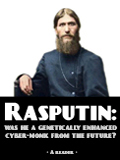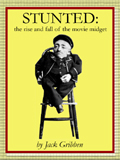 |
Rasputin: was he a genetically enhanced cybermonk from the future?
(Academus Publishers)
Ed. Peter Fowls
Although far from exhaustive, this anthology provides a rounded overview of the debate that has surrounded the mad monk for almost a century. Excerpts from all the major essays are presented with explanatory notes, courtesy of editor Peter Fowls. The result is a refreshingly readable introduction to a strange and controversial subject.
One of the earliest studies in the field was published by Prof. Georg Tjkensin in 1934. He argued that Rasputin was an operative from a futuristic Bolshevik utopia led by the resurrected corpse of Lenin. Tjkensin claimed that Lenin had sent Rasputin back in time to sow the seeds of revolution Ė by sleeping with loads of woman and thus undermining the influence of the Tzarist dynasty.
This theory was widely contested by later historians, most notably by Thomas Renot (1971) who made the controversial claim that Rasputin was neither a time traveller nor a human, but in fact a member of a benevolent race of alien beings. Renot believed that Rasputin was put on earth in order to further mankindís knowledge of the universe Ė by prompting us to evolve to the point of being able to conceive of the possibility that he might be a genetically enhanced cyber-monk from the future, and consequently directing our speciesí consciousness towards the concepts of time travel and genetics.
Renotís work fell out of favour during the 80s when Fressa Marden (1985) put forth a convincing thesis suggesting that Rasputin was indeed from the future, but was actually female. This became the generally accepted view until a recent book by Hank Peterson (1999) made the audacious, but logically-flawless claim that while it is true that Rasputin was a genetically enhanced cyber-monk, his purpose in returning to the late 19th century was not to topple the Russian monarchical regime, but simply to act as a source of inspiration for the 1978 Boney M hit, Ra-Ra-Rasputin. With breathtaking erudition, Peterson went on to explain how one of the bandís dancers, Maizie Williams, used the money she made from the single to open a hospice for deformed sea-lions. This, argues Peterson, was the real objective of Rasputinís time travelling mission.
This anthology is accessible enough to whet the appetite, and confusing enough to encourage further reading. The debate is sure to continue.
|
|







|



